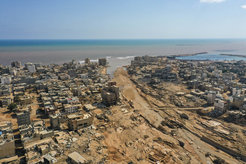2023 – a year of climate extremes
The devastating storms, rainfall, heatwaves and droughts of the past year have become more likely and more severe as a result of global warming
2023 was another year of climate extremes. The global average temperature this year was 1.48 degrees Celsius above the pre-industrial average. At the same time, there were exceptional heatwaves and droughts, extreme storms and catastrophic rainfall. Studies by the European consortium Xaida, in which a team from the Max Planck Institute for Biogeochemistry is also involved, now confirm that such anthropogenic climate change makes extreme weather and climate events more likely and more severe. Partner organizations in the consortium have now presented analyses of how global warming has influenced individual extreme events.

From June onwards, every month in 2023 was warmer than the corresponding month in previous years since measurement data has been available. In the second half of the year, temperatures were more than 1.5 degrees Celsius above pre-industrial levels; on some days they even exceeded 2 degrees more. For the whole of 2023, the global temperature rise thus averaged 1.48 degrees above the pre-industrial average temperature, which is determined based on temperatures between 1850 and 1900. The warming can be partly explained by the fact that the El Niño phenomenon began to develop in the tropical Pacific.
The warmer average temperature also intensified some extreme events, as researchers from the Xaida consortium have discovered. This is true, for example, of the extreme rainfall of Storm Daniel, which caused two dams to burst in Libya in September. The floods claimed thousands of lives and made Daniel the deadliest storm in Africa to date. "We estimate that the extreme rainfall associated with Daniel has become at least ten times more likely as a result of climate change," says Friederike Otto, a scientist at the Grantham Institute at Imperial College London. Through the use of climate models, climate scientists are able to determine the likelihood of a particular extreme event in two different climate scenarios: one with the current global average temperature and the other with pre-industrial temperature levels.
The amount of precipitation may increase during heavy rainfall because warmer air absorbs more moisture. In addition to wind speeds of up to 322 kilometres per hour, this was one reason why Hurricane Otis severely devastated Acapulco in October. According to a team from the French CRNS, Otis was an unprecedented event that can be attributed to anthropogenic climate change.
Temperatures above 50 degrees Celsius will also become possible in Europe
Partners of the Xaida consortium also analysed the heatwaves in which temperatures rose to more than 50 degrees Celsius in the USA and China in July. This level of heat can be fatal. Southern Europe was also exceptionally hot in the summer of 2023, and according to a study by ETH Zurich, temperatures of more than 50 degrees Celsius will also be possible here in the future.
In many parts of the world, exceptionally hot summers are typically also very dry, and droughts are also becoming more likely and more severe as a result of climate change. In some cases, this has dire consequences for agriculture. Over the past 40 years, heat and drought have reduced crop yields even in the northern hemisphere, as a team from the Helmholtz Centre for Environmental Research UFZ has determined. Some regions in the Global South are even more heavily affected. Syria and Iraq, for example, have been experiencing an exceptional drought for three years. With global warming of 1.2 degrees Celsius, the probability of this happening is already 25 times higher than before the onset of anthropogenic climate change.
AI-supported predictions on the consequences of extreme events

The research that one Max Planck group is conducting in Xaida could therefore be beneficial to agriculture, particularly in the countries of the Global South. The team led by Markus Reichstein, Director at the Max Planck Institute for Biogeochemistry in Jena, is developing a method to predict the consequences of extreme events for vegetation, such as crops. To do so, they analyse extensive meteorological, geographical and biological data with the help of artificial intelligence (AI). Among other things, they combine meteorological observations from the Sentinel satellites at a spatial resolution of 20 metres with topographical data and data on plant characteristics. "The same weather can have very different consequences in different regions," says Markus Reichstein. "For example, in 2021 there was just as much heavy rainfall in the Uckermark as in the Ahr Valley, but due to the different geography there was no disaster." And drought is less likely to affect plants on a north-facing slope or in a hollow than on a south-facing slope.
"Predictions that take such differences into account require a level of complexity that is not possessed by physical models," explains Markus Reichstein. "What's more, we don't yet fully understand many of the connections." Artificial intelligence, however, recognizes patterns in data on past heavy rainfall events or droughts that enable predictions to be made about future events. "Aid organizations can then better adapt to this and deploy their resources in a targeted manner," says the climate researcher. Although aid organizations are already using weather forecasts to prepare for impending disasters, artificial intelligence is set to predict even more precisely in future where help will be needed. The Max Planck researchers from Jena will initially apply their method in cooperation with the German Red Cross in Somalia and Kenya to help herdsmen there better adapt to drought. "We're not yet using AI-based predictions," says Markus Reichstein. "But we want to make progress this year."

